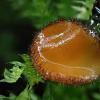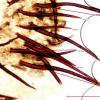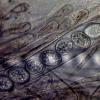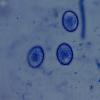
01-10-2004 05:23
 Christian Lechat
Christian Lechat
L'un d'entre vous aurait-il une idée du Genre auq
Scutellinia scutellata?
Christopher Engelhardt,
09-10-2016 17:56
 Aware that Scutellinia scutellata is probably a whole species group, I wonder whether something more can be said about this Asco that I found today in N Germany on lying dead poplar wood, mostly on the cut edge between mosses.
Aware that Scutellinia scutellata is probably a whole species group, I wonder whether something more can be said about this Asco that I found today in N Germany on lying dead poplar wood, mostly on the cut edge between mosses.Fruitbody ~5 mm, hairs dark brownish, mostly 400-750 µm long, up to 16x septate, ending sharply pointed.
Asci mostly rounded at the end, 200-260 µm long, about 20 µm in diameter.
Spores with many small oil drops, smooth, seemingly double-walled, 15-17 x 22-23 µm.
Paraphyses 3-4 µm wide, at the end widening up to 9 µm.
Scutellinia scutellata?
Thanks & best wishes Chris
Michel Delpont,
09-10-2016 18:38

Re : Scutellinia scutellata?
Hello Christopher
Could you make a preparation of spores in the blue cotton outside Asci ?
Michel.
Could you make a preparation of spores in the blue cotton outside Asci ?
Michel.
Christopher Engelhardt,
09-10-2016 19:24
Malcolm Greaves,
09-10-2016 21:10
Re : Scutellinia scutellata?
Hello Christopher
The spore shape/size and ornamentation and the hair length/septa/root and being flexous all fit very well with S olivascens for me.
Mal
The spore shape/size and ornamentation and the hair length/septa/root and being flexous all fit very well with S olivascens for me.
Mal
Michel Delpont,
09-10-2016 21:34

Re : Scutellinia scutellata?
Good evening and Christopher Malcolm
Malcolm was faster than me to answer; I was in the moment to hesitate between S.olivascens and S.kerguelensis, but I'd rather S.kerguelensis over ornamentation and form spores that seems closer to me. But as often with this kind it is sometimes difficult to decide.
Michel.
Malcolm Greaves,
10-10-2016 01:10
Re : Scutellinia scutellata?
Michel
I did look at S kerguelensis. The spore ornamantation looks small as you would expect for the species but I felt the hairs especially the roots looked a better fit for S olivascens. Beñat has S k as having hairs 130-480 but with so many similarities between the species so I couldn't argue strongly agains S kerguelensis.
Mal
I did look at S kerguelensis. The spore ornamantation looks small as you would expect for the species but I felt the hairs especially the roots looked a better fit for S olivascens. Beñat has S k as having hairs 130-480 but with so many similarities between the species so I couldn't argue strongly agains S kerguelensis.
Mal
Michel Delpont,
10-10-2016 09:39

Re : Scutellinia scutellata?
OK! Thank you Malcolm.
Michel.
Michel.
Christopher Engelhardt,
10-10-2016 10:24

Re : Scutellinia scutellata?
Thanks Malcolm and Michel, for this interesting discussion.
After this discussion and further research I'd go for olivascens, the main rerason being the hairs and their roots. In olivascens the hairs are longer than in kerguelensis, some of them s-shaped (not so in kerguelensis) and mostly bifurcate (in kerguelensis only one third so), multiple-septate (in kerguelensis only sparsely septate).
An interesting description of S. olivascens in German language I found in
http://www.pilzforum.eu/board/thema-scutellinia-olivascens--29656
which fits very well to my collection.
So thanks again and best wishes
Chris
After this discussion and further research I'd go for olivascens, the main rerason being the hairs and their roots. In olivascens the hairs are longer than in kerguelensis, some of them s-shaped (not so in kerguelensis) and mostly bifurcate (in kerguelensis only one third so), multiple-septate (in kerguelensis only sparsely septate).
An interesting description of S. olivascens in German language I found in
http://www.pilzforum.eu/board/thema-scutellinia-olivascens--29656
which fits very well to my collection.
So thanks again and best wishes
Chris




